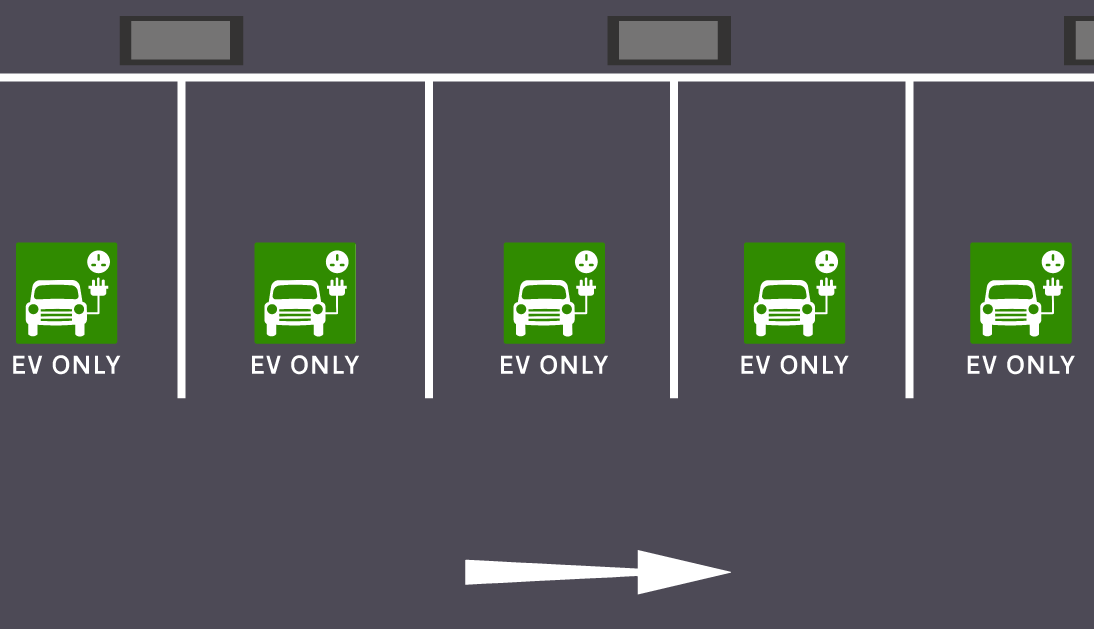As the adoption of electric vehicles (EVs) continues to accelerate globally, the demand for designated EV parking spots is rising in cities, towns, workplaces, and residential complexes. These spaces are critical in ensuring the smooth integration of EVs into everyday life by offering both convenient parking and accessible charging facilities. Properly marked EV parking spaces not only make it easier for EV drivers to find a place to charge their vehicle, but also prevent misuse by non-EV vehicles.
In this post, we will explore the importance of EV parking markings, their typical designs, and the various approaches for marking EV bays on both public and private land.
The Rise of Electric Vehicle Parking
With electric vehicles rapidly gaining traction, EV parking spaces are no longer a novelty but a necessity in modern infrastructure. Public car parks, residential complexes, and workplaces are increasingly incorporating dedicated spaces for EVs, reflecting the growing number of electric vehicles on the road. What makes EV parking unique is not only the need for space but also the integration of EV charging stations within these parking areas.
Common Locations for EV Parking Spots:
- Public car parks (shopping centres, airports, etc.)
- Workplace parking areas
- Residential complexes and apartment buildings
- Service stations and motorway rest stops
In each of these locations, clear and well-maintained markings for EV parking bays ensure smooth access to charging facilities, helping to support the global shift toward cleaner, more sustainable transportation.

Why Marking EV Parking Spots Matters
Clarity and Availability: The purpose of clear EV parking markings is to ensure these spaces are easily distinguishable from regular parking spots. Since charging times can vary from quick top-ups to several hours, EV drivers need to identify available spots quickly and with minimal confusion. Vibrant colours such as green or blue are often used to distinguish EV spaces from other parking areas.
Prevention of Misuse: One of the key issues that arise with EV parking is the misuse of these spaces by non-electric vehicles. By creating clearly marked, vibrant EV-only spaces, the likelihood of these spots being taken up by traditional internal combustion engine (ICE) vehicles is reduced. Misuse of these spots can cause significant inconvenience for EV drivers, especially in locations where charging stations are limited.
EV Parking Markings: Design and Standards
Colour Schemes and Markings: EV parking spots are typically marked with green or blue lines, which visually separate them from standard parking spaces. These colours not only stand out but are also associated with eco-friendly transportation and sustainability.
Symbols and Logos: EV parking bays are also marked with symbols indicating the presence of a charging station. In many countries, on public land, EV bays must include the S65 symbol, which is a standard symbol for electric vehicle charging points. This ensures uniformity and ease of recognition for drivers.
For private land, there is more flexibility in the choice of design. Businesses, residential complexes, and shopping centres can choose from a variety of designs to mark their EV spaces, though it's still important to make sure the symbols and signage are clear, easily identifiable, and visible from a distance.
Public vs. Private Land: Differences in Marking Standards
One of the key considerations when planning and marking EV parking spaces is whether they are located on public or private land.
Public Land:
- Regulatory compliance: On public land, such as municipal car parks or roadside parking areas, strict regulatory standards often dictate the design and markings of EV spaces. The use of standardised symbols such as the S65 symbol is required by law to maintain consistency across different locations and ensure clear recognition for EV drivers.
- Consistency in design: These parking spots must adhere to national or regional regulations that dictate the width of the lines, the colour used, and the positioning of the charging station symbols.
Private Land:
- Custom flexibility: On private land, including shopping centres, residential complexes, or corporate campuses, property owners have more flexibility in terms of design. While many private operators still choose to follow public standards for consistency, they can also get creative with colour schemes and symbols that align with their branding or specific needs. However, it’s important to maintain clear signage to avoid confusion for EV drivers.
- Optional features: Private facilities might incorporate unique designs or symbols that highlight other benefits, such as fast-charging or ultra-fast charging stations. Some may even offer VIP parking for electric vehicle drivers, marked with premium symbols or additional branding.

Best Practices for Marking EV Parking Spots
- Ensure Visibility: Use bright and distinguishable colours like green or blue to make EV parking spots stand out. The markings should be visible day and night, in both bright and low-light conditions.
- Use Standardised Symbols: When marking EV spaces on public land, ensure compliance with local regulations and use standardised symbols like the S65 symbol. For private spaces, symbols should still be clear and recognisable to avoid misuse or confusion.
- Maintain Consistency Across Locations: For businesses or residential complexes with multiple locations, it’s a good idea to use the same design and colour scheme across all sites. This consistency builds familiarity and trust with drivers.
Conclusion: The Future of EV Parking
The demand for electric vehicle parking spots is only set to grow as more consumers and businesses make the switch to electric transportation. Clear and effective EV parking markings play a crucial role in supporting this transition, ensuring that drivers have easy access to the charging infrastructure they need. Whether on public or private land, the right markings can enhance both the functionality and accessibility of EV spaces, helping to shape the future of urban mobility.